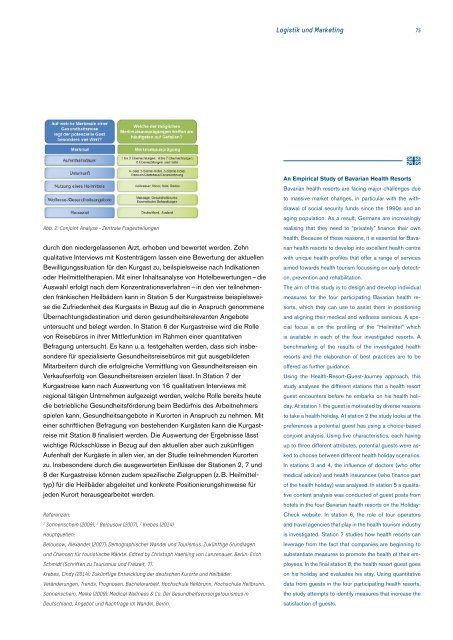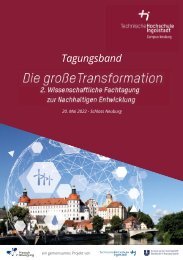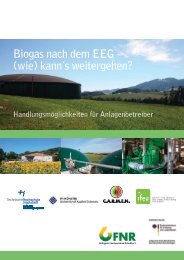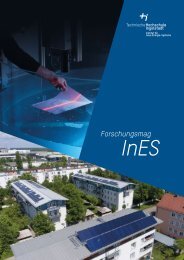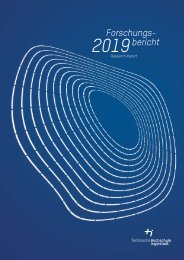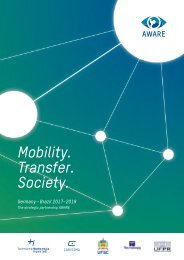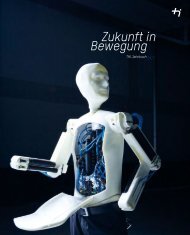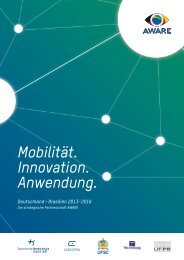thi_forschungsbericht_2017
Forschungsbericht 2017
Forschungsbericht 2017
Erfolgreiche ePaper selbst erstellen
Machen Sie aus Ihren PDF Publikationen ein blätterbares Flipbook mit unserer einzigartigen Google optimierten e-Paper Software.
Logistik und Marketing<br />
75<br />
Abb. 2: Conjoint Analyse – Zentrale Fragestellungen<br />
durch den niedergelassenen Arzt, erhoben und bewertet werden. Zehn<br />
qualitative Interviews mit Kostenträgern lassen eine Bewertung der aktuellen<br />
Bewilligungssituation für den Kurgast zu, beilspielsweise nach Indikationen<br />
oder Heilmitteltherapien. Mit einer Inhaltsanalyse von Hotelbewertungen – die<br />
Auswahl erfolgt nach dem Konzentrationsverfahren – in den vier teilnehmenden<br />
fränkischen Heilbädern kann in Station 5 der Kurgastreise beispielsweise<br />
die Zufriedenheit des Kurgasts in Bezug auf die in Anspruch genommene<br />
Übernachtungsdestination und deren gesundheitsrelevanten Angebote<br />
untersucht und belegt werden. In Station 6 der Kurgastreise wird die Rolle<br />
von Reisebüros in ihrer Mittlerfunktion im Rahmen einer quantitativen<br />
Befragung untersucht. Es kann u. a. festgehalten werden, dass sich insbesondere<br />
für spezialisierte Gesundheitsreisebüros mit gut ausgebildeten<br />
Mitarbeitern durch die erfolgreiche Vermittlung von Gesundheitsreisen ein<br />
Verkaufserfolg von Gesundheitsreisen erzielen lässt. In Station 7 der<br />
Kurgastreise kann nach Auswertung von 16 qualitativen Interviews mit<br />
regional tätigen Untrnehmen aufgezeigt werden, welche Rolle bereits heute<br />
die betriebliche Gesundheitsförderung beim Bedürfnis des Arbeitnehmers<br />
spielen kann, Gesundheitsangebote in Kurorten in Anspruch zu nehmen. Mit<br />
einer schriftlichen Befragung von bestehenden Kurgästen kann die Kurgastreise<br />
mit Station 8 finalisiert werden. Die Auswertung der Ergebnisse lässt<br />
wichtige Rückschlüsse in Bezug auf den aktuellen aber auch zukünftigen<br />
Aufenhalt der Kurgäste in allen vier, an der Studie teilnehmenden Kurorten<br />
zu. Insbesondere durch die ausgewerteten Einflüsse der Stationen 2, 7 und<br />
8 der Kurgastreise können zudem spezifische Zielgruppen (z. B. Heilmitteltyp)<br />
für die Heilbäder abgeleitet und konkrete Positionierungshinweise für<br />
jeden Kurort herausgearbeitet werden.<br />
Referenzen:<br />
1<br />
Sonnenschein (2009), 2 Belousow (2007), 3 Krebes (2014)<br />
Hauptquellen:<br />
Belousow, Alexander (2007): Demographischer Wandel und Tourismus. Zukünftige Grundlagen<br />
und Chancen für touristische Märkte. Edited by Christoph Haehling von Lanzenauer. Berlin: Erich<br />
Schmidt (Schriften zu Tourismus und Freizeit, 7).<br />
Krebes, Cindy (2014): Zukünftige Entwicklung der deutschen Kurorte und Heilbäder:<br />
Veränderungen, Trends, Prognosen. Bachelorarbeit. Hochschule Heilbrunn, Hochschule Heilbrunn.<br />
Sonnenschein, Meike (2009): Medical Wellness & Co. Der Gesundheitsvorsorgetourismus in<br />
Deutschland, Angebot und Nachfrage im Wandel. Berlin.<br />
An Empirical Study of Bavarian Health Resorts<br />
Bavarian health resorts are facing major challenges due<br />
to massive market changes, in particular with the withdrawal<br />
of social security funds since the 1990s and an<br />
aging population. As a result, Germans are increasingly<br />
realising that they need to “privately” finance their own<br />
health. Because of these reasons, it is essential for Bavarian<br />
health resorts to develop into excellent health centre<br />
with unique health profiles that offer a range of services<br />
aimed towards health tourism focussing on early detection,<br />
prevention and rehabilitation.<br />
The aim of <strong>thi</strong>s study is to design and develop individual<br />
measures for the four participating Bavarian health resorts,<br />
which they can use to assist them in positioning<br />
and aligning their medical and wellness services. A special<br />
focus is on the profiling of the “Heilmittel” which<br />
is available in each of the four investigated resorts. A<br />
benchmarking of the results of the investigated health<br />
resorts and the elaboration of best practices are to be<br />
offered as further guidance.<br />
Using the Health-Resort-Guest-Journey approach, <strong>thi</strong>s<br />
study analyses the different stations that a health resort<br />
guest encounters before he embarks on his health holiday.<br />
At station 1 the guest is motivated by diverse reasons<br />
to take a health holiday. At station 2 the study looks at the<br />
preferences a potential guest has using a choice-based<br />
conjoint analysis. Using five characteristics, each having<br />
up to three different attributes, potential guests were asked<br />
to choose between different health holiday scenarios.<br />
In stations 3 and 4, the influence of doctors (who offer<br />
medical advice) and health insurances (who finance part<br />
of the health holiday) was analysed. In station 5 a qualitative<br />
content analysis was conducted of guest posts from<br />
hotels in the four Bavarian health resorts on the Holiday-<br />
Check website. In station 6, the role of tour operators<br />
and travel agencies that play in the health tourism industry<br />
is investigated. Station 7 studies how health resorts can<br />
leverage from the fact that companies are beginning to<br />
substantiate measures to promote the health of their employees.<br />
In the final station 8, the health resort guest goes<br />
on his holiday and evaluates his stay. Using quantitative<br />
data from guests in the four participating health resorts,<br />
the study attempts to identify measures that increase the<br />
satisfaction of guests.


